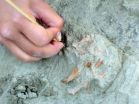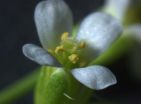(Press-News.org) Queen Mary scientists working with images from NASA's Cassini spacecraft have discovered strange half-mile-sized objects punching through parts of Saturn's F ring, leaving glittering trails behind them.
These trails in the rings, which scientists are calling 'mini-jets', fill in a missing link in our understanding of the curious behaviour of the F ring. The results will be presented today (24 April) at the European Geosciences Union meeting in Vienna, Austria.
Scientists have known that relatively large objects like the moon Prometheus (as long as 92 miles across) can create channels, ripples and snowballs in the F ring. But until recently they didn't know what happened to these snowballs after they were created.
Now Professor Carl Murray, Nick Attree, Nick Cooper and Gareth Williams from Queen Mary's Astronomy Unit have found evidence that some of the smaller snowballs survive, and their differing orbits mean they go on to strike through the F ring on their own.
Professor Murray's group happened to see a tiny trail in an image from 30 January 2009 and tracked it over eight hours. The long footage confirmed the small object originated in the F ring, so they went back through the Cassini image catalogue to see if the phenomenon was frequent.
"The F ring has a circumference of 550,000miles (881,000kilometers) and these mini-jets are so tiny they took quite a bit of time and serendipity to find," said Nick Attree, a Cassini imaging associate at Queen Mary. "We combed through 20,000 images and were delighted to find 500 examples of these rogues during just the seven years Cassini has been at Saturn."
The small objects appear to collide with the F ring at gentle speeds – something on the order of about 4 mph (2 meters per second). The collisions drag glittering ice particles out of the F ring with them, leaving a trail 20 to 110 miles (40 to 180 kilometers) long.
Professor Murray commented: "I think the F ring is Saturn's weirdest ring, and these latest Cassini results go to show how the F ring is even more dynamic than we ever thought. These findings show us that the F ring region is like a bustling zoo of objects from a half mile to moons like Prometheus a hundred miles in size, creating a spectacular show," he added.
In some cases, the objects travelled in packs, creating mini-jets that looked quite exotic, like the barb of a harpoon. Other new images show grand views of the entire F ring, showing the swirls and eddies that ripple around the ring from all the different kinds of objects moving through and around it.
Linda Spilker, Cassini project scientist based at NASA's Jet Propulsion Laboratory, commented: "Beyond just showing us the strange beauty of the F ring, Cassini's studies of this ring help us understand the activity that occurs when solar systems evolve out of dusty disks that are similar to, but obviously much grander than, the disk we see around Saturn. We can't wait to see what else Cassini will show us in Saturn's rings."
###The Science and Technology Facilities Council is the UK sponsor of astronomy.
Cassini sees new objects blazing trails in Saturn ring
2012-04-25
ELSE PRESS RELEASES FROM THIS DATE:
Prions in the brain eliminated by homing molecules
2012-04-25
Toxic prions in the brain can be detected with self-illuminating polymers. The originators, at Linköping University in Sweden, has now shown that the same molecules can also render the prions harmless, and potentially cure fatal nerve-destroying illnesses.
Linköping researchers and their colleagues at the University Hospital in Zürich tested the luminescent conjugated polymers, or LCPs, on tissue sections from the brains of mice that had been infected with prions. The results show that the number of prions, as well as their toxicity and infectibility, decreased drastically. ...
An unexpected virus reservoir
2012-04-25
Where do viruses dangerous to humans come from, and how have they evolved? Scientists working with Prof. Dr. Christian Drosten, Head of the In¬stitute for Virology at the Universitätsklinikum Bonn, have made significant progress in answering this question. "We already knew from prior studies that bats and rodents play a role as carriers of paramyxoviruses," said Prof. Drosten. The many varied members of this large virus family cause, e.g., measles, mumps, pneumonias and colds. The highly dangerous Hendra and Nipah viruses cause types of encephalitis that result in death ...
Mysterious 'monster' discovered by amateur paleontologist
2012-04-25
Around 450 million years ago, shallow seas covered the Cincinnati region and harbored one very large and now very mysterious organism. Despite its size, no one has ever found a fossil of this "monster" until its discovery by an amateur paleontologist last year.
The fossilized specimen, a roughly elliptical shape with multiple lobes, totaling almost seven feet in length, will be unveiled at the North-Central Section 46th Annual Meeting of the Geological Society of America, April 24, in Dayton, Ohio. Participating in the presentation will be amateur paleontologist Ron ...
'Inhabitants of Madrid' ate elephants’ meat and bone marrow 80,000 years ago
2012-04-25
Humans that populated the banks of the river Manzanares (Madrid, Spain) during the Middle Palaeolithic (between 127,000 and 40,000 years ago) fed themselves on pachyderm meat and bone marrow. This is what a Spanish study shows and has found percussion and cut marks on elephant remains in the site of Preresa (Madrid).
In prehistoric times, hunting animals implied a risk and required a considerable amount of energy. Therefore, when the people of the Middle Palaeolithic (between 127,000 and 40,000 years ago) had an elephant in the larder, they did not leave a scrap.
Humans ...
ORNL, Yale take steps toward fast, low-cost DNA sequencing device
2012-04-25
Researchers at Oak Ridge National Laboratory and Yale University have developed a new concept for use in a high-speed genomic sequencing device that may have the potential to substantially drive down costs.
"The low cost--if it can be achieved--would enable genomic sequencing to be used in everyday clinical practice for medical treatments and preventions," said Predrag Krstic, project director and former ORNL physicist now at the University of Tennessee-ORNL Joint Institute for Computational Sciences.
The research is part of a nearly decade-long drive by the National ...
Soy-based S-equol supplement reduces hot flash frequency, muscle & joint pain in US women
2012-04-25
Northridge, Calif. (April 24, 2012) – A dose of 10 milligrams (mg) daily of S-equol delivered via a newly developed fermented soy germ-based nutritional supplement is as effective as a standard dose of soy isoflavones at reducing hot flash frequency significantly and is even more effective for relieving muscle and joint pain, according to a peer-reviewed study in US postmenopausal women published in the June Journal of Women's Health, available now as a Fast Track article online ahead of print.
"This study provides evidence that daily doses of the supplement S-equol, ...
Molecule movements that make us think
2012-04-25
VIDEO:
A research group at Linköping University has built five different molecular models of the voltage sensor in an ion channel, which together can explain all the experimental data. The five...
Click here for more information.
Every thought, every movement, every heartbeat is controlled by lightning-quick electrical impulses in the brain, the muscles, and the heart. But too much electrical excitability in the membranes of the cells can cause things like epilepsy and cardiac ...
PNAS: Precise molecular surgery in the plant genome
2012-04-25
This press release is available in German.
The new method is based on the natural repair mechanism of plants. So-called homologous recombination repairs the genome when the genome strands in the cell break. "Using an appropriate enzyme, i.e. molecular scissors, we first make a cut at the right point in the genome and then supply the necessary patch to repair this cut," says Friedrich Fauser from Karlsruhe Institute of Technology, who is the first author of the PNAS publication. "A part of this patch is the new gene piece we want to install. The rest is done by the ...
The search for a job begins and ends with you
2012-04-25
Staying motivated is always tough, but it certainly gets easier when you start seeing results. That's why keeping your spirits up during a job search can be extremely difficult. Candidates often face repeated rejection and rarely receive any feedback. A new study that focuses on finding work following a job layoff reveals just how important managing negative thoughts and effort over time are while looking for employment.
The research shows that having a more positive, motivational outlook had a beneficial effect on job pursuit, especially at the outset of the search. ...
Family history of liver cancer increases risk of developing the disease
2012-04-25
A family history of liver cancer is reported to increase risk of developing hepatocellular carcinomas (HCC), independent of hepatitis according to findings published in the May issue of Hepatology, a journal of the American Association for the Study of Liver Diseases. The study also shows 70-fold elevated risk of HCC in those with liver cancer in the family and markers for hepatitis B (HBV) or hepatitis C (HCV).
Liver cancer ranks sixth in incidence and the third cause of mortality worldwide. According to the World Health Organization (WHO) liver cancer was responsible ...

